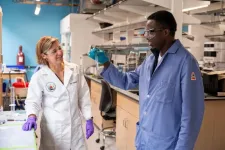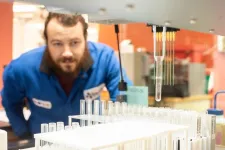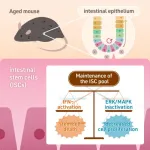(Press-News.org) Researchers at Baylor College of Medicine, the Jan and Dan Duncan Neurological Research Institute (Duncan NRI) at Texas Children's Hospital, Baylor Genetics and collaborating institutions provided a long-awaited and rare genetic diagnosis in a child with Lennox-Gastaut syndrome, a type of developmental epileptic encephalopathy (DEE), associated with a severe, complex form of epilepsy and developmental delay.
Their recent study reports that a highly complex rearrangement of fragments from chromosomes 3 and 5 altered the typical organization of genes in the q14.3 region of chromosome 5, leading to a rare condition known as 5q14.3 microdeletion syndrome. This is the first reported case of chromosomes 3 and 5 reshuffling leading to a form of DEE due to the disruption of 5q14.3. The study appeared in the American Journal of Medical Genetics: Part A.
“About half of the children with severe epilepsy do not have a diagnosis; there is no explanation for their condition. We wanted to change this situation,” said co-corresponding author Dr. Hsiao-Tuan Chao, assistant professor of pediatrics-neurology, molecular and human genetics and neuroscience at Baylor. “For the last five years my lab has been working with Texas Children’s and Baylor Genetics to improve our ability to uncover new genetic causes for childhood epilepsy through our Undiagnosed Epilepsy Genetics Initiative supported by the Cain Pediatric Neurology Research Foundation.”
In the current study, the team reports the case of a young child with developmental epileptic encephalopathy whose previous genomic studies did not provide a genetic diagnosis.
“The child and the family came to Texas Children’s and the Duncan NRI for answers and our team took a closer look at their genome,” said Chao, who also is a Cain investigator at the Duncan NRI and a McNair Scholar. “Using genome sequencing and fluorescently labeled DNA analyses, we reevaluated the child’s genomic condition and found a highly complex reshuffling of chromosomes 3 and 5 resulting in 5q14.3 microdeletion syndrome.”
This reshuffling of chromosomes, or chromothripsis, is a very intricate chromosomal rearrangement. For reasons that are not yet clear, one or several chromosomes can suddenly break down simultaneously into up to thousands of fragments (Thripsis in Greek means destruction into small parts). The cell then pieces the fragments of the chromosomes back together but in a reshuffled order that is different from the original. This reshuffling usually disrupts the normal function of genes in the chromosome fragments, leading to disease.
Two previous pediatric cases with neurodevelopmental conditions have been reported with loss of the chromosome 5q14.3 region, but in one case the chromosomal reshuffling involved chromosomes 5 and 15 and the other included chromosomes 3, 5, 7, 9 and 18. The case reported in the current study is the first 5q14.3 microdeletion syndrome due to reshuffling of chromosomes 3 and 5.
Chromothripsis is more commonly found in cancer. This and other studies increasingly support that chromothripsis also is involved in neurodevelopmental disorders.
“We also found that the chromosomal reshuffling did not directly affect the gene MEFC2 in chromosome 5, which we know when disrupted causes epilepsy and 5q14.3 microdeletion syndrome, but it impacted a non-coding gene right next to it, called MEF2C-AS1, that regulates the levels of MEFC2,” Chao said. “Loss of MEF2C-AS1 is expected to decrease expression of MEF2C. Our finding further supports emerging evidence that disrupting MEF2C-AS1 can result in neurological characteristics like those seen when the actual MEF2C is disrupted.”
The findings highlight the diagnostic importance of identifying chromothripsis in neurological disorders, such as DEE, that are associated with chromosomal alterations. Precise diagnosis is prognostically important because chromothripsis can be associated with increased cancer risk, which may require these individuals to receive enhanced cancer screenings throughout their lives.
Other contributors to this work include Melina L. Corriveau, Joshua C. Korb, Sydney L. Michener, Nichole M. Owen, Erica L. Wilson, Jamie Kubala, Alicia Turner, Danielle S. Takacs, Lorraine Potocki, John W. Swann, Mingshan Xue and Hongzheng Dai. The authors are affiliated with one or more of the following institutions: Baylor College of Medicine, the Duncan NRI, Baylor Genetics and the Robert and Janice McNair Foundation.
Funding support was provided by the Gordan and Mary Cain Foundation, Anne and Bob Graham Foundation, Elkins Foundation, Robert and Janice McNair Foundation and Burroughs Wellcome Fund.
###
END
Child with rare epileptic disorder receives long-awaited diagnosis
2025-02-13
ELSE PRESS RELEASES FROM THIS DATE:
WashU to develop new tools for detecting chemical warfare agent
2025-02-13
Mustard gas, also known as sulfur mustard, is one of the most harmful chemical warfare agents, causing blistering of the skin and mucous membranes on contact. Chemists at Washington University in St. Louis have been awarded a $1 million contract with the Defense Threat Reduction Agency (DTRA) to develop a new way to detect the presence of this chemical weapon on the battlefield.
As with many chemical threats, quick identification of sulfur mustard is key to minimizing its damage, according to Jennifer Heemstra, the Charles Allen Thomas Professor of Chemistry in Arts & Sciences and principal investigator of the new DTRA grant.
“It’s ...
Tufts researchers discover how experiences influence future behavior
2025-02-13
Neuroscientists have new insights into why previous experiences influence future behaviors. Experiments in mice reveal that personal history, especially stressful events, influences how the brain processes whether something is positive or negative. These calculations ultimately impact how motivated a rodent is to seek social interaction or other kinds of rewards.
In a first of its kind study, Tufts University School of Medicine researchers demonstrate that interfering with the neural circuits responsible ...
Engineers discover key barrier to longer-lasting batteries
2025-02-13
Lithium nickel oxide (LiNiO2) has emerged as a potential new material to power next-generation, longer-lasting lithium-ion batteries. Commercialization of the material, however, has stalled because it degrades after repeated charging.
University of Texas at Dallas researchers have discovered why LiNiO2 batteries break down, and they are testing a solution that could remove a key barrier to widespread use of the material. They published their findings online Dec. 10 in the journal Advanced Energy Materials.
The team plans first to manufacture LiNiO2 batteries in the lab and ...
SfN announces Early Career Policy Ambassadors Class of 2025
2025-02-13
WASHINGTON — The Society for Neuroscience (SfN) has selected 10 members from a highly competitive applicant pool to participate in the Society’s annual Capitol Hill Day on March 11–13, 2025. The 10 Early Career Policy Ambassadors (ECPAs), representing many career stages and geographic locations, were chosen for their dedication to advocating for the scientific community, their desire to learn more about effective means of advocacy, and their experience as leaders in their labs and community.
The ambassadors are:
Izan Chalen, University of Illinois Urbana-Champaign
Nicole D’Souza, University of California, Riverside
Lana Ruvolo Grasser, PhD, Department ...
YOLO-Behavior: A new and faster way to extract animal behaviors from video
2025-02-13
Collecting video data is the long-established way biologists collect data to measure the behaviour of animals and humans. Videos might be taken of human subjects sitting in front of a camera while eating in a group in the University of Konstanz, or researchers using cameras to measure how often house sparrow parents visit their nests on Lundy Island, UK. All these video datasets have one thing in common: after collecting them, researchers need to painstakingly watch each video, manually mark down who, where and when each behaviour of interest happens—a process known as “annotation”. ...
Researchers identify a brain circuit for creativity
2025-02-13
KEY TAKEAWAYS
Brigham researchers analyzed data from 857 patients across 36 fMRI brain imaging studies and mapped a common brain circuit for creativity.
They derived the circuit in healthy individuals and then predicted which locations of brain injury and neurodegenerative disease might alter creativity.
The study found that changes in creativity in people with brain injury or neurodegenerative disease may depend on the location of injury in reference to the creativity circuit.
A new study led by ...
Trends in obesity-related measures among U.S. children, adolescents, and adults
2025-02-13
About The Study: From 2013-2014 to August 2021-August 2023, there were small increases in the percentage of children and adolescents with obesity, as well as in adults with severe obesity (but not obesity). There were no other significant changes in obesity-related measures, including waist circumference. This period included the COVID-19 pandemic; a study using electronic health records found a small increase in mean weight among adults during the pandemic.
Corresponding Author: To contact the corresponding author, Samuel D. Emmerich, DVM, email semmerich@cdc.gov.
To access ...
U.S. abortion bans and fertility
2025-02-13
About The Study: The findings of this study provide evidence that fertility rates in states with abortion bans were higher than would have been expected in the absence of these policies, with the largest estimated differences among subpopulations experiencing the greatest structural disadvantages and in states with among the worst maternal and child health and well-being outcomes.
Corresponding Author: To contact the corresponding author, Suzanne O. Bell, PhD, email suzannebell@jhu.edu.
To ...
U.S. abortion bans and infant mortality
2025-02-13
About The Study: U.S. states that adopted abortion bans had higher than expected infant mortality after the bans took effect. The estimated relative increases in infant mortality were larger for deaths with congenital causes and among groups that had higher than average infant mortality rates at baseline, including Black infants and those in southern states.
Corresponding Author: To contact the corresponding author, Alison Gemmill, PhD, email agemmill@jhu.edu.
To access the embargoed study: Visit our For The Media website at this link https://media.jamanetwork.com/
(doi:10.1001/jama.2024.28517)
Editor’s ...
Safeguarding intestinal stem cells during aging through balanced signaling
2025-02-13
A recent study led by Associate Professor Takuya Yamamoto and Researcher May Nakajima-Koyama has revealed that maintaining a delicate balance between interferon-gamma (IFN-γ) and extracellular signal-regulated kinase (ERK)/mitogen-activated protein kinase (MAPK) signaling is essential for preserving the intestinal stem cell population during aging. By comparing young and aged mouse intestinal tissues, the researchers uncovered critical insights into the interplay between these signaling pathways in supporting stem cell maintenance over time.
The intestinal epithelium exhibits the highest cell ...



